2.5: Combining the Transformations
( \newcommand{\kernel}{\mathrm{null}\,}\)
In the previous sections, we have seen how the various transformations act on the trigonometric functions and we have worked with the first three (amplitude, period and vertical shift) in combination with each other. Combining the phase shift with the other transformations is tricky because of the way that the period and the phase shift interact with each other.
Now we have two standard equations for the sinusoid:
y=Asin(Bx+C)+D
y=Acos(Bx+C)+D

Let's look at an example in which we need to combine a change in the period of the graph with a phase shift.
Example 1
Graph at least one period of the given function. Indicate the important values along the x and y axes.
y=cos(4x+π)
The transformations in this example only affect the x -axis. The period of the function is 2πB=2π4=π2. So, the function will complete one full cycle over a distance of π2 along the x -axis.
However, because of the phase shift, this graph will not start at 0 and end at π2. We need to find the new starting point that is caused by the phase shift. So, we take what is called the "argument," or what it is we're finding the cosine of: (4x+π) and set that equal to zero.
4x+π=04x=−πx=−π4
π2∗14=π8
So, each subsequent critical value along the x -axis will be a distance of π8 from the previous one. If we start at our new starting point for this function −π4, then if we add π8 a total of 4 times, we will arrive at each of the five critical values for this function
−π4+π8=−2π8+π8=−π8−π8+π8=00+π8=π8π8+π8=2π8=π4
−π4,−π8,0,π8, and π4

since there were no changes to the y -axis, the amplitude for the function is 1 and the vertical shift is 0. Along the x -axis, we see a positive sine function that starts at(−π4,0) then goes up to (−π8,1), back down through (0,0) to (π8,−1) and back up to (π4,0) to complete one full cycle of the graph.
Let's look at an example in which there are some changes to the y -axis as well as the x -axis.
Example 2
Graph at least one period of the given function. Be sure to identify critical values along the x and y axes.
y=−52+cos(3x−π)

In this example, the amplitude is 1, since there is no coefficient in front of the cosine function. The vertical shift is −52, which will shift the function down a distance of 2.5 on the y -axis. So, the mid-line or "zero" points of the graph will be at −2.5, the maximum y value will be -1.5 and the minimum y value will be -3.5
Along the x -axis, the period for the graph will be 2πB=2π3, since the coefficient B in this problem is 3. To find the new starting point, we'll take the argument of the cosine function and set it equal to zero.
3x−π=03x=πx=π∗13=π3
14)
2π3∗14=2π12=π6
π3+π6=2π6+π6=3π6=π23π6+π6=4π6=2π34π6+π6=5π65π6+π6=π
2π6,3π6,4π6,5π6, and 6π6
Again, notice that the distance along the x -axis from the starting point to the ending point is the period: 2π3. Now let's graph the function:
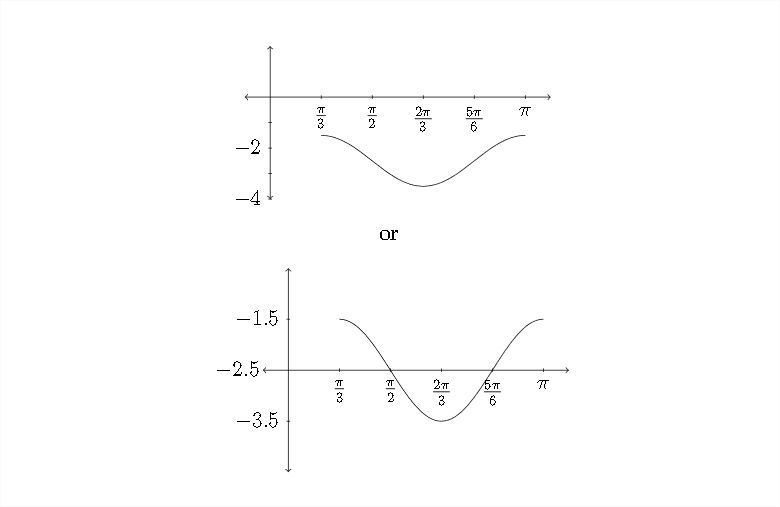
Let's look at one more example.
Example 3
Sometimes the coefficient B appears factored out of the argument as it does in the problem below.
Graph at least one period of the given function. Be sure to include the critical values along the x and y axes.
y=4sin2(x+π3)−1
First let's see how the x and y axes are affected by the transformations in this problem.

y=4sin2(x+π3)−1
The period for this graph is 2πB=2π2=π. Notice that the value of B is 2 in this example, even though it's been factored out from the rest of the argument.
The new starting point for the graph is actually easier to find in problems of this type. If we take the argument as it is and set it equal to zero:
2(x+π3)=0
2(x+π3)2=02x+π3=0x=−π3
So, the new starting point for the function is −π3
Now let's find the rest of the critical values along the x -axis. The period for this graph is π, so the "jump " between the critical values along the x -axis will be:
π∗14=π4
To find the rest of the critical values we'll need to add π4 to the starting point of the graph (−π3) four times:
−π3+π4=−4π12+3π12=−π12−π12+3π12=2π12=π62π12+3π12=5π125π12+3π12=8π12=2π3
−4π12,−1π12,2π12,5π12, and 8π12
−π3,−π12,π6,5π12, and 2π3
Now that we've addressed each of the four transformations let's use this information to draw the graph. First the y -axis - the amplitude is 4 and the vertical shift is -1:
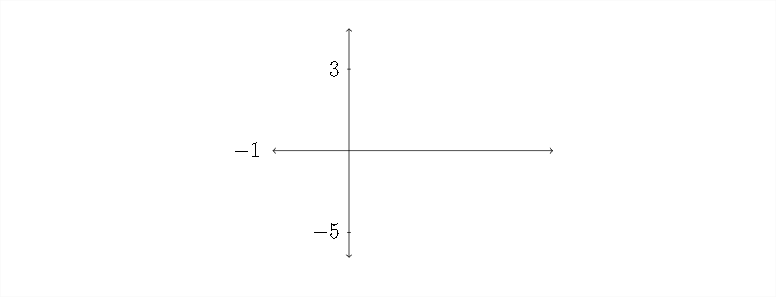
Now, let's fill in the information for the x -axis. The critical values along the x -axis are−π3,−π12,π6,5π12, and 2π3
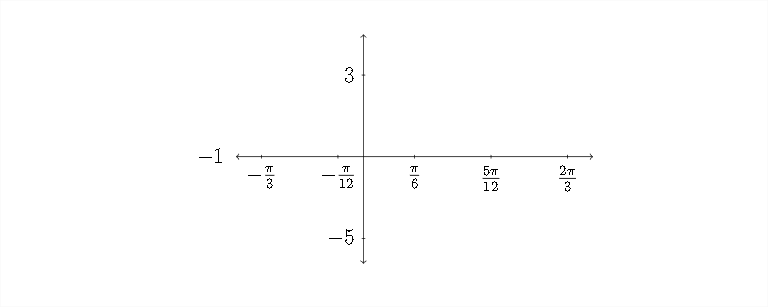
The function we're graphing is a positive sine function, so it will start at the "midline" or zero value (which in this case is -1 ), go up to the maximum, back through the mid-line to the minimum and back to the mid-line:
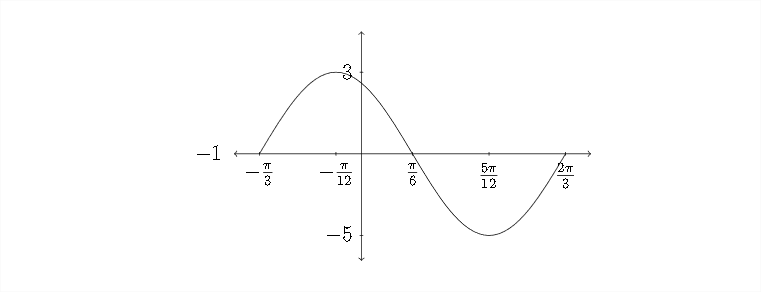
Determine the Amplitude, Period, Vertical Shift and Phase Shift for each function and graph at least one complete period. Be sure to identify the critical values along the x and y axes.
1. y=sin(x+π2)
2. y=sin(x−π)
3. y=3cos(x−π2)
4. y=12cos(x+π)
5. y=3+cos(x−π4)
6. y=−2+sin(x+π6)
7. y=sin(2x−π)
8.y=sin(4x+π4)
9.y=2cos(x2+π)
10.y=−3sin(6x−π)
11. y=−13sin(2x+π4)
12. y=12cos(x2−π)
13. y=2sin(2x−π3)−1
14.y=1+2cos(3x+π2)
15. y=3cos2(x+π6)
16. y=−4sin2(x+π2)
17.y=sin12(x+π4)
18. y=3+2sin3(x+π2)
In problems 19−22, determine an equation for the function that is shown.
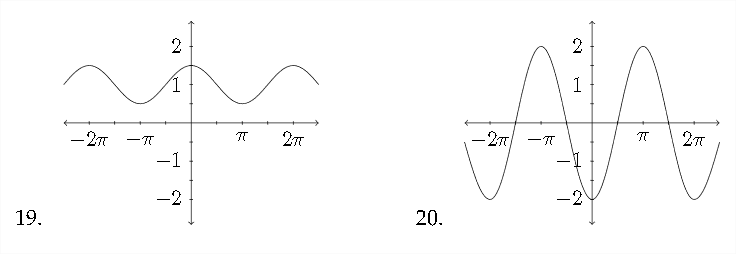

Match the function to the appropriate graph
23. y=−cos2x
24. y=12sinx−2
25. y=2cos(x+π2)
26. y=−3sin12x−1
27. y=sin(x−π)−2
28. y=−12cos(x−π4)
29. y=13sin3x
30. y=cos(x−π2)
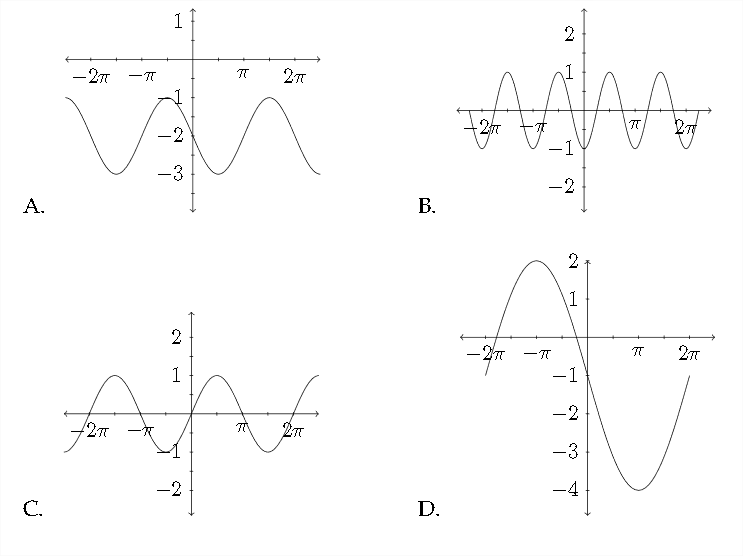
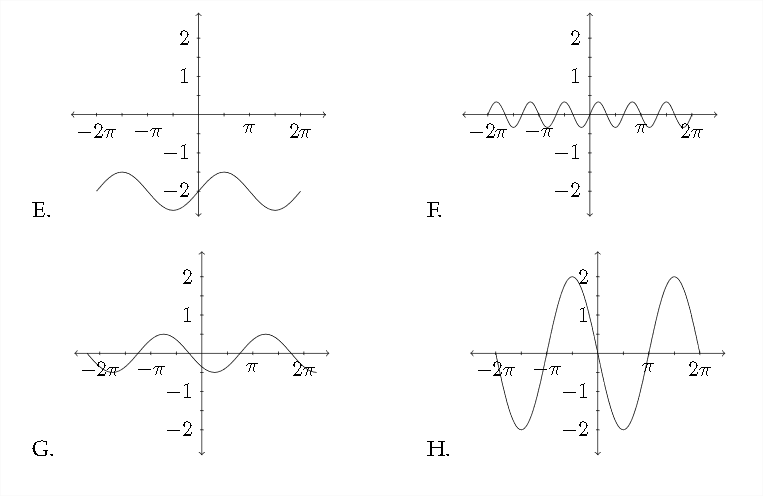
Determine the Amplitude, Period, Vertical Shift and Phase Shift for each function and graph at least one complete period. Be sure to identify the critical values along the x and y axes.
31. y=2cos(2x+π2)−1
32. y=−4cos(3x−2π)
33. y=sin(2x−π4)
34.y=−sin(3x+π)
35. y=3cos(x+π3)+1
36. y=−2sin(3x−π2)+4
37. y=−12sin(x−π2)−2
38. y=2−cos(2x−π3)


